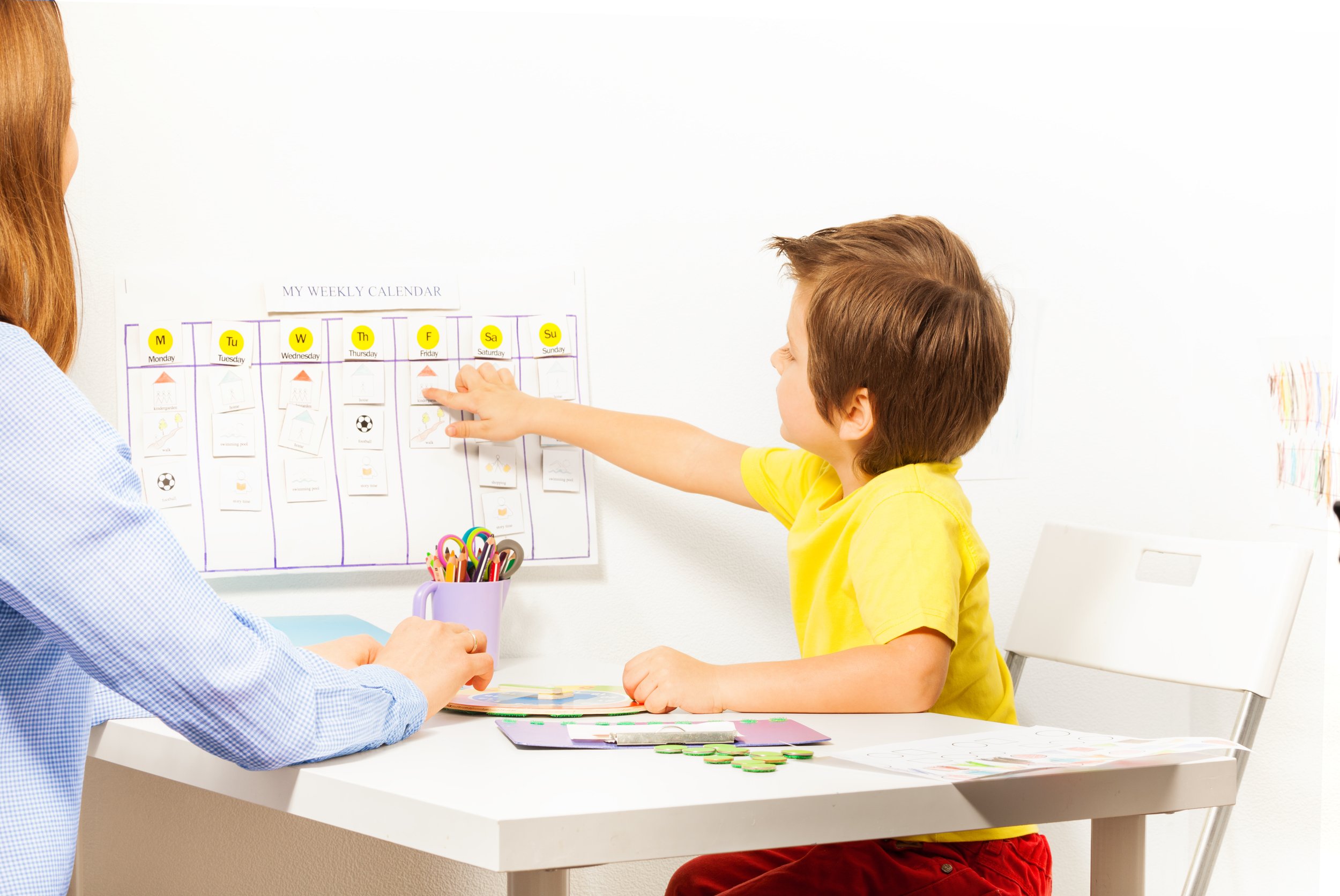6 Tips to Wrap Up Your Homeschool Year
Get your end-of-the-year record-keeping and organizing done so you can enjoy some time off.
Get your end-of-the-year record-keeping and organizing done so you can enjoy some time off.
It’s May and I’ve lost my mojo. I even doubled my caffeine intake to no avail.
It seems most every homeschooling parent gets to a point when they need to wrap up their school year. Even those parents that homeschool year-round, feel the pull of spring in May; the need to be done.
Homeschooling parents can quickly be overcome with the amount of material that’s accumulated throughout a long and creative homeschool year. Wrapping up the year can seem overwhelming. Here are some tips to get that clutter off your kitchen counter and put the homeschooling year to bed.
1. File end of year paperwork.
Be sure to file any end of year paperwork required in your district. Evaluations, portfolios, or other measures of progress, as well as letters of intent to homeschool, may be due now. Spend some time and get those out of the way so you can enjoy the summer days.
2. Update transcripts/report cards and evaluations.
Don’t wait for months to finalize report cards or evaluations. You will want to complete this task while the information is fresh in your mind. Tracking courses and progress is especially important if you are creating a transcript for your high schooler. Grades, field trips, courses, online classes, community groups, service projects, lab work, job experience, internships, apprenticeships, extracurricululars; all are easily lost or forgotten if not immediately recorded. Unschoolers should also record any classes, experiences or community involvement for their portfolio or transcript.
Unit studies can be easily put away in file folders labeled with the year or grade of the child.
If your child has completed a class through another organization, be sure to gather certificates of completion or grades from the teacher, if that is offered as part of the class.
Kids' school work can also be saved digitally. Take a photos and file in a folder for your portfolio or create a scrapbook of your incredible year. Grandparents especially love thumbing through scrapbooks and sharing memories with their grandchildren. Scrapbooks are also a great way to deter naysayers who might think your kids sat around eating Cheetos all year long.
3. Toss the rubbish.
What do you do with the hordes of paperwork that have accumulated? If your children are in their elementary years, save a few special pieces of artwork and toss the rest. The craft stores have pizza-style boxes that you can buy which are great for storing both artwork and academic work. The pizza boxes stack and store easily on a shelf, don’t take up much room, and hold a lot of material. Save one or two papers each month from each subject and toss the rest. I usually save one paper that shows beginning skills and one that shows mastery. My district/state doesn’t require evaluations of our work but I do save the boxes for three years and then get rid of them.
If you have many 3D sculptures, dioramas, hanging mobiles, and the like for art projects, it can be tougher to part with these masterpieces. Gifting the grandparents or aunts and uncles is a great way to share your homeschooling days with relatives. We always told our kids that if it didn’t fit in the storage box, we could not keep it. Certainly, a few special pieces were kept but the majority went into the box or were gifted away.
4. Clean up the extras.
Dump the moldy bread science experiment that’s been sitting on your shelf for weeks. Organize your homeschool space if you have one, clean off the desks, put the glue sticks and crayons back in their holders, give everything a good spring-time scrub down.
5. Label and store books.
I have a filing system for all of my books. At one point, I was homeschooling three kids in three different grade levels. The number of books, texts, instruction manuals, and other material accumulated through the years, was astounding. Before you pack everything up for the year, label the inside of every single book with an approximate grade level. Include chapter books, workbooks, and manipulatives in this process. I also place grade level stickers on the spines, so that when I store them, I can easily pull the next grade level I need for the coming year. Having organized books has been a lifesaver on so many occasions.
Donate, sell, or trade any items that you won’t use again. As my kids aged up through grades, I save curricula that was going to be used again. Any grade level items that we’d no longer use were donated or sold.
6. Plan some fun activities to celebrate
Get out of the house by planning some time with friends to celebrate the great weather. A picnic in the park, care-free playground days, lunch out with the kids, or a field trip can give you some much needed energy to push through those last few weeks of homeschooling.
Be proud of all your kids have accomplished this year. Don’t worry about the small things that didn’t get completed. Your children have likely learned so much exploring their own love of learning. Enjoy these last days and finish strong!
7 Easy Ways to Simplify Your Homeschool Day
If your homeschool schedule isn’t making your life happier, easier, and more productive, isn’t it time to change things so that it is? Beverly has some great tips for creating a homeschool schedule that works for you.
How can homeschoolers get their work done and still find time for fun? It’s all about balance and letting go.
Let’s face it. Some homeschool days can drag on and on. There are days we overschedule, days when the kids seem to take forever to complete the simplest of tasks, and still other days where an emergency visit to the doctor to have an eraser removed from your two-year-old’s nose takes precedence.
As the summer winds down, many homeschoolers are looking for ways to schedule their homeschool year without pulling their hair out. How do we balance it all without feeling like we are tied to textbooks at our kitchen table? Here are seven ways I’ve learned to relax and finish our day in record time.
1. Stop when you achieve mastery.
Does your child really need to do those thirty math problems just because they are in the workbook? Do they understand the concept by completing only ten problems? Go with that, and move on when your child has mastered the skill. Don’t feel obligated to complete work just because it’s there or because a textbook publisher thought six pages was the appropriate amount of learning in this lesson.
2. Skip the parts that don’t speak to you.
We use textbooks as more of a guide, rather than a script to follow. We pull out what we need and what excites us, and ditch the rest. All of the links, bonus questions, extra experiments, and “check this out” areas need not be done. Keep it simple.
3. Combine subjects when you can.
Combining subjects is a great way to streamline homeschooling time. Work in language arts essays with history work. Combine art and language arts. We use unit studies when we can. And some subjects, like history and science, can work for kids at multiple levels with minimal adjustment on either end. Even if you’re not ready to lean all the way into this, combining a few subjects is a terrific way to seamlessly blend subjects into a cohesive learning experience.
4. Make a schedule that works.
Not every subject or learning experience needs to be covered every day. Try a four-day schedule, and leave the fifth day for down time or for finishing up projects or work that needs more attention. Try a Monday, Wednesday, Friday/Tuesday, Thursday schedule. Maybe foreign language or physical education only needs to be done twice a week. If you are scheduling every subject daily, be sure that you are realistic about the amount of material you think you can cover.
5. Don’t let your schedule rule the day.
Schedules and routines look great on paper, but the reality is that the day seldom goes as planned. If we miss an assignment due to illness, or life, we simply move it to the next day. I also evaluate the lesson to decide if this is something that can be tossed entirely. Certainly, you don’t want to skip learning that needs to happen in progression, but tossing an experiment, art project, or busy work is perfectly acceptable.
6. Stop comparing.
Comparing your day or homeschool to others is a quick way to lose confidence. Comparing makes you feel as if you can’t keep up with what everyone else is doing. Set goals for YOUR children and YOUR homeschool, and work toward those. On days when you fall short, look at the bigger picture of what has been accomplished and where learning has leapt ahead.
7. Try something different.
If you are feeling suffocated by a schedule, try tossing it to the side. Go with the flow for a few days and see how the kids are responding. If it’s working, great; if not, try again. Unschooling can be a great way to alleviate the pressure of a schedule. Give it a go to see if it works for your family.
Pinterest, blogs, curriculum providers, and Instagram can suck time from our day and make us want to try every new thing that comes along. Loosely schedule what you want to cover each week in a planner and then whittle it down to more specific details. Be flexible when you don’t get to everything. Tomorrow’s another day.
Why You Need a Homeschool Review Mid-Year
The halfway point of your homeschool year is a great time to check in with your kids about what's working — and what isn't.
The halfway point of your homeschool year is a great time to check in with your kids about what's working — and what isn't.
For many homeschoolers, the year is halfway through, and maybe you are wondering what you’ve accomplished? The New Year is a perfect time to reflect on your homeschool plans, and give a good review of everything you have done so far. Rather than feel pressured to do what other homeschool families are doing, take time to reflect on what is, and isn’t working in your homeschool.
A mid-point review will propel your homeschool forward and help you tweak areas that need a little extra attention. Here are five tips for reviewing your homeschool year.
Whenever a new year approaches, I start with the goals I set way back in the summer.
1. Review your goals
Whenever a new year approaches, I start with the goals I set way back in the summer. The wonderful thing about goals, is that they can be changed. Take a hard look at what worked, what partially worked, or what didn’t work at all. Adjust your goals as needed, or write new ones. As homeschooling parents, we sometimes get goal setting wrong for our children. Just as we think we have it figured out, the kids do a complete one-eighty and turn us on our backsides. Kids learning does not happen in a straight line, so know that your goals will need adjusting, rewriting, or just plain tossing out.
2. Stay organized
Staying organized is paramount in homeschooling. Believe it or not, I was far more organized homeschooling three children than I am with just one. Keeping up with three kids, each with five-plus subjects and extracurriculars, is enough to make any homeschooling mom a bit crazy. I had a detailed system each week for doing lesson plans, reviewing work, and reaching goals. As the last child moves up through the ranks, I find that I’m still organized, but perhaps far more relaxed.
At the midpoint of the year, I review several things:
Is my child on track with the amount of work completed? Is he chapters behind, on track, or ahead? If lagging, a schedule change may be in order. If your child is ahead, it may indicate that a more challenging curriculum is needed. Be aware that children often learn in bursts and might tackle several topics or chapters very quickly. They might also struggle with topics that are challenging and spend significant time to complete them. A few weeks behind or ahead doesn’t likely warrant an immediate change. Observe to see if a speed-up or slow-down is a recurring pattern or the normal ebb and flow of childhood learning.
Is the quality of work acceptable? Is my child getting the work done just to get it off his plate? Or is he spending quality time on the topic?
Are grades on point? If you use grading as a measurement in your homeschool, are your children where you want them to be? Do you need to outsource extra help to get them over a hump?
What curricula is not working? Don’t be afraid to toss that math curriculum if it’s making everyone miserable, and doesn’t encourage learning.
Is your portfolio up to date? Those in states that require mid-year reporting, or portfolio review will want to stay on top of paperwork. Take care of that now before the mid-point review.
Ask your children what is working, and do more of that. Toss out, adjust, rearrange, or revamp what isn’t working. Involved kids are more invested in their learning.
3. Don’t Worry What Others Are Doing
Comparison can quickly derail any homeschool. The quickest way to feel like a failure is to compare yourself with other homeschooling families. It doesn’t matter if the Jones’ children go to music class every day and play five instruments. Homeschooling allows us to meet our children where they are and to create a learning environment developed specifically for them. Comparison will always make you feel like you are living in a world of lack, rather than abundance. Celebrate the milestones and joys along the way, and resist the urge to compare.
4. Avoid Overwhelm
Overwhelm can quickly turn the best day, into the worst. If a mid-year review has you wondering if you were ever out of your car for more than five minutes or wondering how you managed to get any homeschooling done, you might need to scale down what you are doing. Jam-packed schedules can lead to burnout and overwhelm. Are the fun things constantly being pushed to the side so that you can squeeze in one more activity? Take a hard look at your schedule to see what can be dropped in the coming year. Drop things that no longer serve you or your child (clubs, playgroups, co-ops, homeschool groups, music, classes, sports, etc.). Save your time for those things that make your heart sing.
5. Ignore Opinions
Don’t give power to people who aren’t responsible for making decisions about your children. Friends and relatives may be full of advice, ready to tell you what they think you should do. Relatives may be quick to point out all the things that they think are going wrong, where you lack in parenting skills and knowledge, and what your children need in terms of a solid education. Let them know that their opinion isn’t needed at this juncture because you have made the best decision possible for your kids. Spend some time creating appropriate responses that honor your choices, while emphatically letting them know that you have it all under control.
Mid-year reviews are a perfect time to reflect on all you have accomplished and where you want to be in the coming months. Reviews are also a great way to open the lines of communication between parent and child.
If you feel like you are never accomplishing enough, keep a journal of your daily activities, milestones, and significant leaps in learning. It’s an incredible reminder of the path you have chosen in home educating your child!
How to Keep the Spirit of Gratitude Alive All Year
Keep the spirit of gratitude and giving alive in your homeschool after all the winter holidays are over with these tips from Beverly.
Gratitude. It seems to be in the forefront of our thoughts especially during the holidays. But, how many of us genuinely practice gratitude all year long?
Aside from the heart-tugging commercials about donating to your local food shelter, or adopting a family on Christmas; there are ways to teach your children how to have a heart of gratitude not just in the giving seasons. As homeschoolers, we have the unique opportunity to instill and share values of gratitude with our children all throughout the year.
1. SHOW YOUR APPRECIATION
Encouraging gratitude in children is best done by modeling the behavior. Daily routines of expressing gratitude help children understand that the practice begins at home.
Try some of the following:
- At dinner time, have each child and adult write down one thing they are grateful for that happened that day.
- Place the folded pieces of writings in a gratitude jar. At the end of the week or even on New Year’s Day, read the entire jar’s worth of writing. It’s a great reminder not only of how much you have shared as a family but about those who care for you each day.
2. ASK FOR HELP
Asking for help is something that everyone must do at some point in life. Asking younger children to help with meal preparation, clean up, and daily chores helps them realize that contributing makes a difference to everyone. People feel appreciated when others lend a hand and help. Talk to your children about the experiences of both giving and receiving help.
3. VOLUNTEER
Regular volunteering can foster a lifelong attitude of giving back to community. While volunteering around the holidays is always needed, making time to serve all year long, exposes children to the long-term benefits of helping and gratitude.
Families sometimes find it difficult to search for opportunities for younger children to volunteer, but children of all ages have many opportunities to give in their community. Those people who aren’t as socially active as they used to be often love the presence of young children and helpers. After volunteering, ask your children how they felt, how they think those that they helped felt, and what more they could do to help in the future. Remind children that gratitude is often unspoken, and that their purpose is to help others, even if words of thanks don’t always accompany the act.
Consider some of the following if you’re having trouble locating volunteer opportunities:
- Visiting nursing homes to play board games with the residents or to sing songs.
- Maintaining a garden at group homes.
- Helping at a CSA (community supported agriculture) farm.
- Donating food and care at animal shelters.
- Offering lawn care to elderly.
- Spending some time in a soup kitchen or clothing outlet for the homeless.
- Putting together bags for the needy with toiletries, lip balm, protein bars, socks, gloves, and hats. Check with your local shelter to see what they need.
- Knitting or crocheting hats for premature babies.
- Walking a neighbor’s dog.
Try to make volunteering a regular tradition to foster gratitude all year long.
4. GIVE EXPERIENCES, NOT THINGS
Instead of Grandma and Grandpa giving your children plastic toys for every holiday and birthday, encourage them to give the gift of experiences and time. Experiences help grow and deepen family connections.
Ask relatives and friends for memberships to the zoo, or aquarium. Or perhaps a special lunch and movie date can be become a new tradition. Take lots of photos of the event, and gift the giver with a special card or photo album of the wonderful day as a thank you. Children will remember and cherish the special outing for years to come.
5. EXPRESS GRATITUDE FREELY AND OFTEN
Children learn from observing the behavior around them. Be sure to express your own gratitude for their efforts, and for being part of the family. Show kindness and gratitude when you are out in stores or markets or whenever kindness is shown to you. It’s easy to overlook small efforts as not being worthy of gratitude, but even small acts of kindness go a long way in the eyes of children.
Instilling the gifts of gratitude in the hearts of children does not happen overnight.
Tips to Help Homeschool Your Perfectionist Child
Beverly has some practical ideas to make homeschooling a little less stressful for you and your perfectionist child.
In my early homeschooling days, I was sidelined by a perfectionist child. I had high hopes of correcting everything that went wrong in public school, and worked diligently to close every learning gap. I read up on every method of homeschooling there was, and chose only the best curriculum I could find. Then I started to homeschool my oldest, and my plan quickly derailed. This child had learned a level of perfectionism that no one could compete with. In her eyes, every math problem must be correct, every bit of prose perfectly written—and rewritten, and written yet again. Art was a disaster—especially anything that required free-form expression. The lack of structure was anxiety producing to her, and the constant revamping and start-overs led to a mishmash of art that looked more like mud pies.
The early days in homeschooling my perfectionist child were difficult. At first, I saw this as a reflection of my teaching skills, but I quickly learned how to help my child and myself, during this trying time.
Do You Have a Perfectionist Child?
Children may be perfectionists by nature or by learned behaviors and requirements. Regardless of the cause, helping a perfectionist child is not easy and takes time. Both teacher and student need patience and understanding to make homeschooling work with the perfectionist child.
Perfectionists set incredibly high standards for themselves and experience great pain and distress if they fail to meet those standards. Even when they have done well, they are often aware of what feel like inadequacies in their work.
Recognizing a perfectionist may not be easy. Often, they can appear lazy or unwilling to work. This is not the case at all, and in fact, some perfectionists are highly driven individuals.
Perfectionists may have some of the following traits:
- Unwillingness to answer questions or participate for fear of being wrong
- Anxiety or anger if they get work wrong, receive low marks, or make mistakes
- Excessive time taken to complete projects and tasks. Or reworking projects and tasks until “perfect”
- Inability to start tasks due to overwhelm
- Inability to complete tasks
- Not being satisfied with a standard of work which others see as acceptable
- Highly critical of others’ work or difficulty working on group projects
Perfectionism in homeschooled students is a problem in several ways. First, perfectionism not only slows children down, but it also slows their rate of learning and leads to missed learning time. These children tend to focus so deeply on the task at hand, that they miss vital instruction surrounding the topic.
Second, perfectionistic children may refuse to guess answers or try new activities. Children who don’t guess or explore possibilities in their learning have less opportunity to problem-solve.
Both the slow rate of learning and the missed learning can be detrimental to a child’s ability to learn. Homeschoolers can use several methods to help their perfectionist child.
10 Ways to Help a Perfectionist Child
Children, by nature, rarely achieve perfection in anything they do, but there are ways to help a perfectionist child start to feel okay about that. Children need our help to understand that it is normal, expected, and okay to make mistakes.
1. We need to point out to them that everyone has strengths and weaknesses. People aren't born knowing everything or being able to do everything.
2. Explain to them that goals may take longer to reach. Help them see that it takes a lot of practice to succeed in some activities and that it's normal to try and fail many times.
3. Children need to understand that some things come easily to people and some do not.
4. When correcting work, be sure to point out the areas where the child did well. A missed stepped does not equal failure. Especially in math, if the child understands the concept but calculated the final answer wrong, think about how you help them see where the error occurred: “You understood steps 1 through 6, but let’s look at step 7 again.”
5. If your perfectionist writer won’t stop revising their work, try reading back to them. Sometimes, hearing the text can help them quickly correct grammatical or contextual errors.
6. Work on helping them set deadlines for completion: “Be sure you have done all the revising you need to by 2 p.m.”
7. Encourage draft work. Perfectionist children still need to be allowed time to correct work that is subpar. Give them positive feedback and explicit direction on the areas that need attention. Highlighting draft areas that need correcting is a great way to help a child focus on that specific area. Be sure to tell them that anything not highlighted should be left as is.
8. Help children recognize the time and skill needed to reach a goal. Perfectionist kids may be overly confident in their abilities to complete a task or goal. Help them plan time, equipment, outlines, and skills needed BEFORE they start any task. Assure that they come to you frequently to assess the path they are on.
9. Encourage children to tackle small amounts of work rather than large projects at first. Shorter assignments allow for faster completion.
10. Value the effort more than the outcome. Praise efforts of guessing and trying regardless if wrong or right. Acknowledge work that is completed on time and left alone. Help your child see that it is possible to learn for the pure joy, without needing to create an end product that will be evaluated or graded.
Homeschooling can provide some relief for children who are driven to do all assignments perfectly. It can be a chance for parents and children to reduce external pressures and stress, that are often put-upon children in other educational settings.
Perfectionist children can be a challenge to teach in the homeschool setting. It can wear thin on both parent and child, but it’s important to remember that any challenge can be overcome with patience and perseverance. Spend time with your child, listen to their concerns, and help them manage their time and energy in completing the homeschool day. Remember too, when dealing with perfectionist children, that the journey is long, but it can be achieved!
13 Tips for Attending Homeschool Conferences
Homeschool conferences can be overwhelming, but also incredibly informative. I recently attended a homeschool conference and here’s what I learned.
1. Bring a friend and a notebook.
Many of the workshops you would like to attend may be scheduled at the same time. Split up the workshops with a friend, and divide and conquer. Take notes during the workshops. It will be impossible to remember everything you heard and learned. A notebook will help jog your memory when you’ve had time to decompress from all you learned. At the end of the day, compare notes with your friend and share information. You will gain twice as much confidence and information with a friend.
2. Take as much information as you can in the vendor hall.
Vendors have material available because they want you to become informed, and want your business. Even if you think you are not interested in what a vendor has to offer, check out their product, and take their promotional material. Once home, it’s easier to digest all the information over a cup of coffee and some quiet time. You may just be inspired by something you didn’t know you needed or wanted!
3. Make a game plan.
Vendor halls and workshops can be overwhelming, especially at larger conventions or conferences. Be sure to check out the schedule and make a game plan on what you need. Ask the staff at the registration table for any updates to the schedule. Speakers and workshops schedules sometimes get moved because of attendance numbers, or other factors. You don’t want to miss your favorite workshop, so be sure to inquire. If the registration desk has a map of the vendor hall, review it before entering. Also make note of where the restrooms are located and local restaurants or the food court. Staying nourished and hydrated is important.
4. Ask to lock in sales prices.
If you can’t purchase now, ask the vendor if they can lock in the sales price that is offered at the conference. Most vendors will offer an extended sales price during the conference and for a week or so after the conference.
5. Check with speakers or workshop hosts to see if there is a webinar or audio version of the workshop that you can get free or purchase.
There is so much information to take in, that being able to listen to keynote speakers again, may be a benefit in your homeschooling.
6. Rest.
Grab lunch with a friend and decompress from the convention noise and overwhelm. Sitting outside for a while can help you regain some clarity, and give you energy to tackle the next workshop or vendor hall. Wear comfortable shoes.
7. Bring bags.
Most conference will offer a reusable bag as part of the vendor hall experience, but purchases, flyers, and PR material can quickly fill up your bags. Better yet, check to see if a rolling cart is allowed into the conference. It will save your back and arms from all the weight of that newly acquired material.
8. Meet and greet.
Introduce yourself to others. Tell your homeschooling story. Ask about theirs. Conferences and conventions are prime real estate for making connections in the homeschool world. Find your common ground, stay connected through social media or other methods, and build your homeschooling network.
9. Thank the coordinators of the event.
So much behind the scenes planning takes place to make homeschool conferences a success. Give helpful suggestions, rather than complaints. Volunteer to help if you can. Even a few hours attending the registration desk is a help to all.
10. Ask questions.
Contact the speakers and vendors if you still have questions about their workshop or product. They will welcome your inquiry for more information.
11. Decide if you will bring children.
Some conferences are child friendly with lots of scheduled kid activities, and others are more geared toward an adult day. Conferences may or may not offer child care or kid activities, so be sure to inquire. Vendor halls can be a long day for children who have no interest in looking at curriculum. Plan accordingly.
12. Plan time for sightseeing.
If you are traveling to a conference be sure to check out the local sites. Homeschoolers never stop learning, and this is a great opportunity to explore the world.
13. Set your budget.
Vendor halls and that shiny new curriculum or online curriculum, can be very tempting to purchase. Be sure you research thoroughly and stick to your budget.
Homeschool conventions are a perfect opportunity to make connections and have all your homeschooling questions answered. Do your research before the convention both on workshops you want to attend, and speakers that you want to hear. When you are in need of a homeschool reboot, a convention can be just the thing to inspire and refresh your world.




















































BEVERLY BURGESS is a Homeschool Coach, Blogger, Inspirational speaker, and author of Out of the Box Learning~Empowering YOU On Your Homeschool Journey.
She lives in Rhode Island with her husband and three children.